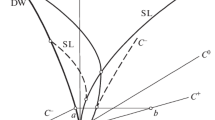Abstract
A two-dimensional steady-state structure of a film flow of a combustible liquid on a heat-conducting substrate in the case of combustion-wave propagation is considered in the hydrodynamic formulation. The physical mechanism of formation of this structure is analyzed. It is shown that the thermocapillary effect plays an important role. The conclusion is justified that the existence of a two-dimensional regime is possible only for rather low values of the temperature gradient on the film surface. A critical condition is obtained, which determines the transition to a three-dimensional regime. This condition implies that the flow velocity is equal to the velocity induced by the thermocapillary force. If the temperature gradient is higher than a certain critical value, a zone with a reverse flow should appear, in accordance with the two-dimensional model. It is assumed that such a regime cannot exist due to its instability to three-dimensional perturbations. Experiments with a liquid film flowing down due to gravity in the presence of an immovable heat source (without the combustion wave) support the conclusion of the transition to a three-dimensional regular flow structure if the temperature gradient is rather high. The first part of the paper deals with simulation of the film structure for the critical condition satisfied. The second part deals with generalization of the problem to the case of a movable heat source moving with a constant velocity. This formulation of the problem includes the situation with combustion-wave propagation. The mathematical formulation of this problem allows us to assume that the existence of a two-dimensional steady-state regime in this case is limited by the same critical condition. If the temperature gradient on the film surface is higher than the critical value, the two-dimensional steady-state solution does not exist. This concept justified in the present work offers a generic explanation of phenomena observed in liquid films in the presence of local heat sources of various natures.
Similar content being viewed by others
REFERENCES
O. A. Kabov, I. V. Marchuk, and V. M. Chupin, "Thermal imaging study of the liquid film flowing on vertical surface with local heat source” Russian J. Eng. Thermophys., 6, No. 2, 105–138 (1996).
O. A. Kabov, "Formation of regular structures in a downward liquid film with local heating” Teplofiz. Aéromekh., 5, No. 4, 597–602 (1998).
L. D. Landau and E. M. Lifshits, Hydrodynamics, Nauka, Moscow (1986).
I. V. Marchuk, "Thermographical study of a liquid film flowing down a surface with a local heat source” Candidate's Dissertation in Phys.-Math. Sci., Inst. Thermal Phys., Sib. Div., Russ. Acad. Sci., Novosibirsk (2000).
A. A. Korzhavin, V. A. Bunev, D. M. Gordienko, and V. S. Babkin, "Behavior of flames propagating over liquid films with metallic substrates” Fiz. Goreniya Vzryva, 34, No. 3, 15–18 (1998).
A. A. Korzhavin, V. A. Bunev, I. G. Namyatov, and V. S. Babkin, "Flame spread over liquid fuel film on metallic substrates” Fiz. Goreniya Vzryva, 36, No. 3, 25–30 (2000).
I. G. Namyatov, S. S. Minaev, V. S. Babkin, et al., "Diffusion combustion of a liquid fuel film on a metal substrate” Fiz. Goreniya Vzryva, 36, No. 5, 12–21 (2000).
Author information
Authors and Affiliations
Rights and permissions
About this article
Cite this article
Sharypov, O.V., Medvedko, K.A. & Fomin, A.V. Limits of Existence of a Two-Dimensional Steady-State Structure of a Liquid Film in Combustion-Wave Propagation. Combustion, Explosion, and Shock Waves 38, 19–23 (2002). https://doi.org/10.1023/A:1014045615046
Issue Date:
DOI: https://doi.org/10.1023/A:1014045615046




